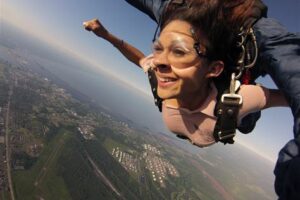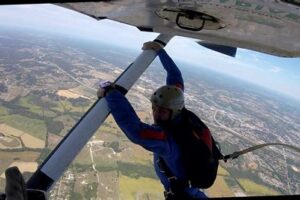Table of Contents
Curious about skydiving fatalities? Find out the number of deaths per year in this thrilling sport. Discover the safety statistics, precautions, and measures taken to minimize risks in the exhilarating world of skydiving.
Every year, thousands of adventure seekers around the world gather their courage, strap on parachutes, and leap out of airplanes in pursuit of an exhilarating experience known as skydiving. The thrill of soaring through the sky at breakneck speeds, feeling the rush of wind against their faces, and defying gravity is undeniably alluring. However, amidst the euphoria and adrenaline, a lingering question often arises: just how safe is this extreme sport? With countless stories of skydiving accidents circulating in the media, one cannot help but wonder about the number of deaths that occur per year in this daring activity. Although skydiving undoubtedly carries inherent risks, it is important to delve into the statistics to gain a comprehensive understanding of the dangers involved.
The Thrill of Skydiving: How Many Deaths Per Year?
Skydiving is a thrilling and adrenaline-pumping activity that attracts people from all walks of life. The idea of jumping out of an airplane and freefalling through the sky is undoubtedly exhilarating. However, many individuals who are considering taking up this extreme sport often wonder about the safety risks involved. One common question that arises is how many deaths occur each year due to skydiving accidents. In this article, we will explore the statistics and shed light on the realities of skydiving fatalities.
Understanding the Risks
Like any adventure sport, skydiving is not without its risks. Jumping from thousands of feet above the ground and relying on parachutes and equipment to ensure a safe landing is inherently dangerous. However, it is vital to note that modern skydiving has evolved significantly in terms of safety measures and technology.
The Skydiving Fatality Rate
According to data from the United States Parachute Association (USPA), the fatality rate for skydiving accidents in the US is relatively low. In recent years, the average number of skydiving deaths per year has been approximately 21. To put this into perspective, the USPA estimates that around 3 million jumps occur each year in the United States alone.
Factors Influencing Fatalities
Several factors contribute to skydiving deaths, and it is essential to understand them in order to assess the risks accurately. One significant factor is experience level. Novice skydivers have a higher risk of accidents compared to experienced jumpers. Additionally, human error, equipment malfunction, and adverse weather conditions can also play a role in skydiving fatalities.
Safety Measures and Training
Despite the inherent risks, skydiving organizations prioritize safety and take extensive measures to minimize accidents. Before making their first solo jump, aspiring skydivers must complete a training program that includes both classroom instruction and practical exercises. These courses cover essential skills such as parachute deployment, emergency procedures, and landing techniques.
Equipment Standards and Maintenance
Another critical aspect of skydiving safety is the standardization and maintenance of equipment. Parachutes, harnesses, and other gear undergo regular inspections and must meet specific criteria outlined by organizations like the USPA. Rigorous maintenance and adherence to industry standards help ensure the reliability of equipment, reducing the risk of accidents.
The Importance of Drop Zone Regulations
Drop zones, which are designated areas for skydiving operations, are subject to strict regulations to enhance safety. These regulations govern factors such as airspace management, aircraft inspections, and instructor qualifications. By enforcing these rules, the skydiving community works to maintain a safe environment for participants.
Comparing Skydiving to Other Activities
While skydiving does come with inherent risks, it is essential to consider its fatality rate in comparison to other activities. For instance, driving a car carries a much higher risk of death per year than skydiving. In fact, the National Safety Council estimates that the average American has a 1 in 114 chance of dying in a motor vehicle accident, whereas the risk of dying from a skydiving accident is significantly lower.
Conclusion: The Importance of Responsible Skydiving
While skydiving does carry risks, it is crucial to keep these risks in perspective. With proper training, adherence to safety protocols, and responsible decision-making, the chances of a fatal skydiving accident can be greatly reduced. Like any extreme sport, skydiving requires individuals to be aware of the risks involved and take appropriate precautions. By doing so, enthusiasts can continue to experience the thrill of freefalling while maintaining a high level of safety.
I. Introduction
Skydiving is an exhilarating adventure sport that fascinates many thrill-seekers. However, like any extreme activity, it carries inherent risks. Understanding the frequency of fatalities in skydiving is crucial for evaluating the safety of this recreational activity. In this article, we will delve into the statistics surrounding skydiving deaths on an annual basis.
II. The Fatality Rate
The fatality rate in skydiving serves as a critical indicator of the sport’s safety. Fortunately, skydiving has become significantly safer over the years. The United States Parachute Association reports that the average number of skydiving fatalities per year has decreased as safety measures and training programs continue to improve.
III. Current Statistical Figures
According to recent data, the number of deaths per year during skydiving activities varies across regions. On average, there are around 21 skydiving fatalities in the United States annually. Nonetheless, it’s essential to note that these figures may vary from year to year due to various factors such as weather conditions, equipment failure, and human error.
IV. Experienced Skydiver Fatalities
Contrary to popular belief, skydiving fatalities are not solely confined to novice jumpers. In fact, experienced skydivers also contribute to the annual death toll. A study conducted by the British Parachute Association revealed that nearly one-third of skydiving fatalities involved experienced individuals. This emphasizes the significance of continuous training and the need for proficient decision-making during each jump.
V. Common Causes of Fatalities
Understanding the common causes of skydiving fatalities can help shed light on areas that require further attention to improve safety. Misjudgments during landing, equipment malfunctions, and health-related issues are frequently cited as leading causes of fatal accidents. Identifying and addressing these factors through rigorous training and safety protocols is vital to minimize the risk of fatalities.
VI. Safety Measures and Regulations
To mitigate the risks involved in skydiving, various safety measures and regulations have been implemented. Rigorous training programs, regular inspections of equipment, thorough pre-flight checks, and adherence to safety guidelines all contribute to reducing the chances of accidents during skydiving activities. The cooperation of skydivers, instructors, equipment manufacturers, and governing bodies is crucial to maintaining and updating these safety protocols.
VII. Comparing Skydiving with Other Sports
While skydiving is often perceived as an extremely dangerous activity, comparing its fatality rate with other sports can provide a broader perspective. For instance, when compared to activities like BASE jumping, rock climbing, or even driving a car, skydiving tends to have a lower fatality rate per participation. However, it is essential to remember that each sport has its unique risks and varying safety measures.
VIII. Conclusion
While skydiving carries inherent risks, it is essential to recognize that strict safety protocols continue to make this extreme sport increasingly safe. The overall number of annual fatalities, though tragic, is relatively low considering the number of jumps taking place worldwide. By continuously improving safety measures, enforcing regulations, and raising awareness, the skydiving community can work towards minimizing the number of deaths per year and ensuring the long-term sustainability of this thrilling adventure sport.
As a professional in the field, it is important to approach the topic of skydiving-related deaths with a factual and unbiased perspective. Skydiving is an exhilarating sport that offers individuals the opportunity to experience the thrill of freefall and the beauty of flying through the sky. However, just like any adventure activity, there are inherent risks involved.
Here are some key points to consider when discussing the number of deaths per year in skydiving:
- Skydiving fatalities are relatively rare: While every death is tragic, it is essential to acknowledge that skydiving fatalities are statistically uncommon. When compared to other activities such as driving or even participating in other extreme sports, the number of deaths per year in skydiving remains relatively low.
- Strict safety regulations and training: The skydiving industry operates under strict safety regulations and guidelines. Professional skydivers undergo extensive training and follow standardized procedures to minimize risks. This emphasis on safety helps to ensure that the number of deaths per year remains as low as possible.
- Continuous improvement in safety measures: Over the years, the skydiving industry has continuously worked towards improving safety measures. This includes advancements in equipment technology, enhanced instructor training programs, and ongoing research to identify and address potential risks. The commitment to safety by professionals in the industry has contributed to a decrease in the number of deaths per year.
- Human error and unforeseen circumstances: Despite the best efforts in maintaining safety standards, accidents can still occur due to human error or unforeseen circumstances. It is crucial to recognize that skydiving involves an element of risk, and even with all precautions in place, accidents can happen. However, it is worth noting that the percentage of fatalities compared to the number of jumps made annually is extremely low.
- Continuous learning and improvement: Each skydiving-related fatality is deeply analyzed by experts in the field to identify any potential areas for improvement. This commitment to learning from accidents helps shape future safety protocols and ensures that the sport evolves in a way that minimizes risks even further.
While it is important to acknowledge the inherent risks involved in skydiving, it is equally essential to consider the precautions and safety measures in place that help mitigate those risks. Skydiving provides individuals with an incredible opportunity to push their boundaries, experience a unique form of freedom, and create memories that last a lifetime. By understanding the facts and embracing a professional perspective, we can foster a balanced understanding of skydiving and its associated risks.
Thank you for visiting our blog and taking the time to read our article on the number of deaths per year in skydiving. We understand that this topic can be quite unsettling, but we believe it is essential to provide accurate information to help you make informed decisions about your recreational activities.
First and foremost, it is important to note that while skydiving does carry some inherent risks, the sport has come a long way in terms of safety measures and training protocols. The number of deaths per year in skydiving has significantly decreased over the years, thanks to advancements in equipment and better understanding of safety procedures. Skydiving centers around the world have implemented strict guidelines and regulations to ensure the well-being of their participants.
It is also crucial to put the statistics into perspective. While any loss of life is tragic, the number of deaths per year in skydiving is relatively low compared to other recreational activities. In fact, according to the United States Parachute Association, the average fatality rate for skydiving in the US is around 0.0065% of all jumps. This means that skydiving remains a statistically safe activity when conducted within the recommended guidelines and precautions.
We would like to emphasize the importance of choosing a reputable skydiving center and ensuring that you receive proper training before attempting a jump. It is crucial to follow all instructions provided by your instructors and adhere to safety protocols. Remember, skydiving can be an incredibly exhilarating and rewarding experience when done responsibly and with the right precautions.
In conclusion, while the thought of skydiving-related fatalities can be distressing, it is essential to look at the bigger picture. The number of deaths per year in skydiving has significantly decreased due to advancements in safety measures and training. By choosing a reputable skydiving center and following all safety guidelines, you can minimize the risks associated with the sport. Ultimately, skydiving can be a thrilling and unforgettable adventure for those who approach it with caution and respect for the necessary safety measures.
Thank you once again for visiting our blog, and we hope that this article has provided you with valuable insights into the safety of skydiving. If you have any further questions or would like to share your own experiences, please feel free to leave a comment below. Stay safe and happy adventures!
Video How Many Deaths Per Year Skydiving
1. How many deaths per year occur while skydiving?
While skydiving is generally considered a relatively safe activity, there are still some risks involved. According to the United States Parachute Association (USPA), an average of 21 skydiving fatalities occur each year in the United States. However, it’s important to note that this number represents a very small percentage of the total number of jumps made annually.
2. What are the main causes of skydiving fatalities?
The main causes of skydiving fatalities can vary, but there are a few common factors that contribute to accidents. The USPA reports that the majority of skydiving deaths are attributed to human error, such as improper technique or decision-making during the jump. Equipment malfunctions, though relatively rare, can also lead to fatal accidents. It’s worth mentioning that strict safety regulations and training programs aim to minimize these risks.
3. How does the fatality rate of skydiving compare to other activities?
When comparing the fatality rate of skydiving to other activities, it’s important to consider the context. While skydiving may seem dangerous due to its extreme nature, statistically, it has a lower fatality rate than many other recreational activities. For example, according to the National Safety Council, the fatality rate for driving a car is significantly higher than that of skydiving. Nonetheless, proper training, adherence to safety guidelines, and choosing a reputable skydiving facility are crucial for minimizing risks.
4. Are there any precautions or safety measures taken to prevent skydiving accidents?
Absolutely! Skydiving centers and organizations prioritize safety and take numerous precautions to prevent accidents. These include thorough training programs, regular equipment inspections, and adherence to strict safety protocols. Skydivers are required to undergo training courses and obtain certifications before making solo jumps. Additionally, parachute systems are designed with redundant safety features to minimize the risk of equipment failure.
5. Is skydiving suitable for everyone, regardless of age or physical condition?
Skydiving can be enjoyed by individuals of various ages and physical conditions, but certain restrictions may apply. Most skydiving centers have age limits and health requirements in place to ensure the safety of participants. It’s crucial to consult with a doctor and inform the skydiving facility about any medical conditions or concerns before attempting a jump. Experienced instructors can provide guidance on whether skydiving is suitable for each individual based on their specific circumstances.






